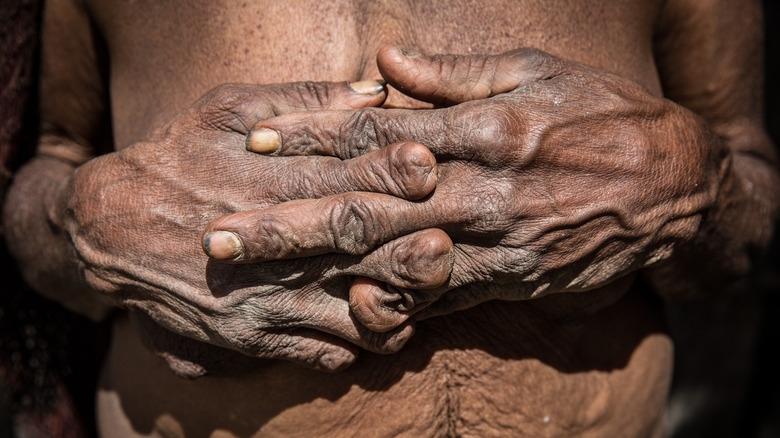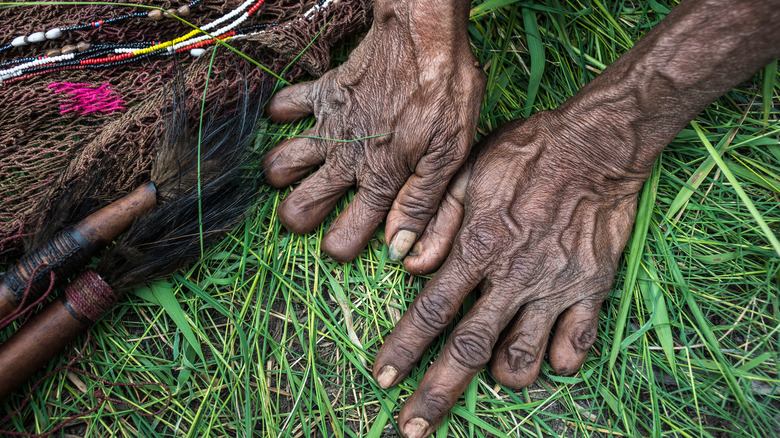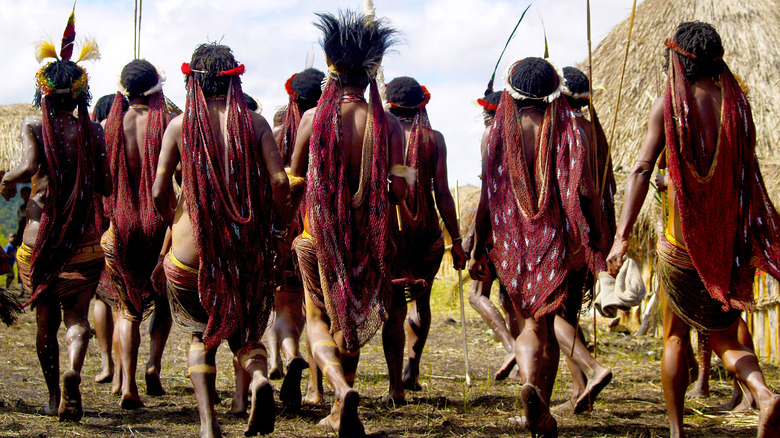Why Some Members Of The Dani Tribe Of Papua, New Guinea Amputate Fingers In Mourning
In 1938, explorer Richard Archbold was flying over the western highlands of New Guinea when he came upon the Dani tribe (per News Australia). According to The Conversation, the tribe has lived in this region for 50,000 years and is like any other community. They farm, trade, and have a thriving agricultural and cultural society. Prior to their discovery by the outside world, the Atlas of Humanity writes the Dani tribe was isolated and even feared by other local tribes. Now, they are well acquainted with the tourists that visit their home in Indonesia's Baliem Valley. As the world around them continued to modernize, the Dani tried to retain their traditions.
This includes a practice called "ikipalin" (via The Guardian Nigeria). The Atlas of Humanity states that this is when a tribe member cuts off the top of their fingers while mourning. Per News Australia, this is said to ward off spirits and is a symbolic gesture that represents the suffering felt when a loved one dies. The 1987 book "Bodies Under Siege" by Armando R. Favazza explains that fingers are ideal for mutilation as it causes little injury and does not entirely disable the individual. The book goes on to say that finger mutilation has been practiced for thousands of years by various cultures. That being said, this custom is now outlawed in Indonesia, although News Australia notes that it's likely still being practiced.
The ritual is predominantly practiced by women
Per "Bodies Under Siege", anthropologists in the 1960s realized that "ikipalin" was mostly being practiced by young women after funerals. News Australia points out that it's unknown when this practice began or why women seem to be at the center of it, however, the mutilation is usually done by a close relative with a stone blade. First, the elbow is hit to minimize the pain of the amputation. Then, the stone blade is used to cut off the fingers. Sometimes, a blade is not used at all. Instead, a piece of rope is tied around the finger or the joints to cut off circulation.
In those cases, eventually, the finger falls off due to the lack of oxygen to the nerves (via News Australia). According to Atlas of Humanity, this is not a one-time deal; several fingers can be mutilated during a tribe member's lifetime to grieve those around them who have died. Anthropologists observed that they viewed Dani women handling children "with hands that are mostly thumbs" (via "Bodies Under Siege"). Nevertheless, The Conversation reports that this ritual is not exclusive to only women, men are known to participate as well. The publication notes that "ikipalin" was widely practiced by women when men died in war rather than from natural causes.
The Dani tribe's other customs
The Guardian Nigeria writes that once the finger has been amputated, the wound is cauterized. The finger is then burned or buried. However, not everyone is on board with this practice. Teh Han Lin, a man from Singapore who photographed the Dani told the Daily Mail "I feel it's a cruel and inhumane practice, but to them this is the only way to show the grievousness to the loved ones and they are willing to do it." Similarly, "Bodies Under Siege" reports that tribes from nearby Papua New Guinea are also known to cut their fingertips off as a mourning practice.
According to News Australia, it's believed that the Dani practice another ritual that involves biting off babies' fingertips to ensure that they live long lives. Additionally, it's believed that they mummify their dead, especially those who were revered while they were still alive. However, The Conversation states that's an uncommon practice and that the Dani usually cremate those who have died. Markus Roth, a German man acquainted with the Dani told Caters New Agency that his time with the tribe was everything he had hoped for. He stated, "It was an amazing experience interacting with them –- they are shy, curious, wild and at the same time -– very warm-hearted."


